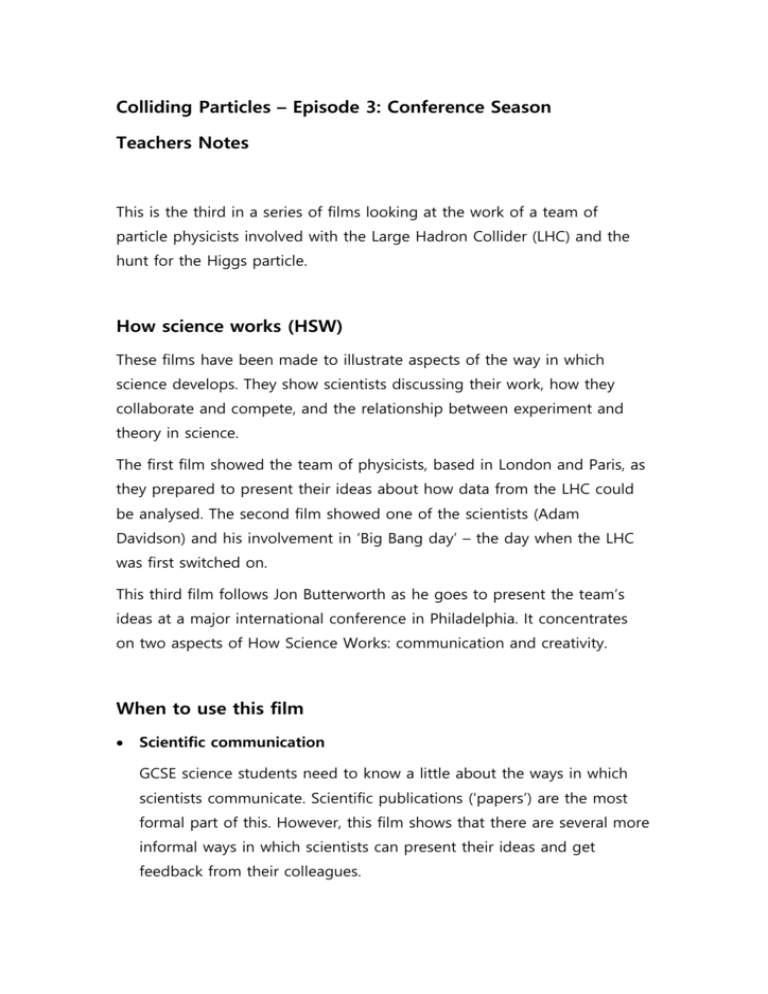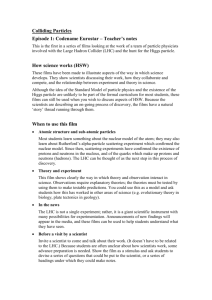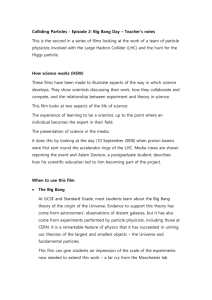LHC films - Colliding Particles
advertisement

Colliding Particles – Episode 3: Conference Season Teachers Notes This is the third in a series of films looking at the work of a team of particle physicists involved with the Large Hadron Collider (LHC) and the hunt for the Higgs particle. How science works (HSW) These films have been made to illustrate aspects of the way in which science develops. They show scientists discussing their work, how they collaborate and compete, and the relationship between experiment and theory in science. The first film showed the team of physicists, based in London and Paris, as they prepared to present their ideas about how data from the LHC could be analysed. The second film showed one of the scientists (Adam Davidson) and his involvement in ‘Big Bang day’ – the day when the LHC was first switched on. This third film follows Jon Butterworth as he goes to present the team’s ideas at a major international conference in Philadelphia. It concentrates on two aspects of How Science Works: communication and creativity. When to use this film Scientific communication GCSE science students need to know a little about the ways in which scientists communicate. Scientific publications (‘papers’) are the most formal part of this. However, this film shows that there are several more informal ways in which scientists can present their ideas and get feedback from their colleagues. The activity sheet provides a structured approach to developing students’ understanding of how scientists communicate. The film could also be used as a starting point for an activity where students make their own presentations to the class about an area they have researched. Scientific creativity Towards the end of the film, we see scientists who are attending the conference enjoying a visit to the local art gallery. While some choose to spend the time in further discussions of their work, Jon takes the opportunity to compare creative thinking in science and art. He describes both of these as ways of seeing the world and explains the importance of mental images as an aid to scientific thinking. In their studies of art, students will have come across different genres such as pop art and surrealism. You could discuss how these operate: what constraints do they work within and how do they change the way we see the world? You could also look back to artists such as Leonardo da Vinci for whom representations of nature were closely related to scientists’ developing understanding of the world. Showing the film The film can be shown straight through and uninterrupted. This will allow students to obtain a general view of the nature of a scientific conference. Subsequently, the film can be shown in sections (see Summary), with a discussion of the main points arising after each section. One approach would be to use the activity sheet to structure students’ viewing of the film. This concentrates on the first 7 minutes or so of the film, concerned with scientific communication. You could pause the film after each section and discuss briefly the answers to the questions (see below). The activity sheet Communicating science asks students to prepare a poster on How scientists communicate. This could be a homework activity. (Students could re-view the film from the collidingparticles.com website.) Then, to give a flavour of a conference poster session, they could pin their posters up and discuss them with other members of the class. The activity sheet Creativity in science discusses the role of imagination and creativity in science. Devising a new theory, designing a new experiment – these are both creative acts. The activity sheet asks students to think about two ‘particle’ experiments (Brownian motion and Rutherford’s alpha scattering) with which they are likely to be familiar. How do ‘images’ play a part in understanding these important experiments? Notes on the activity sheet: Communicating science Students are provided with a number of stimulus questions to guide their viewing. Here are some notes on these questions: Conference talk What is the venue like? – Several big lecture halls are used, with the possibility of seating hundreds of people. How does Jon get his ideas across? – Speaking, using a slideshow on the screen. How do people let Jon know what they think about his talk? – questions and answers at the end of the talk, conversation immediately after, possibility of having a chat late on. Poster session What is a scientific poster like? – Title plus author details; mixture of text, graphics, data etc. Why might a scientist present a poster rather than giving a talk? – work-in-progress can be presented without the formality of a lecture presentation. Also, at large conferences there is not enough time for everyone to make a presentation, and poster sessions provide a democratic platform for people to present their work. Informal conversation What are the benefits of talking face-to-face? – People can respond immediately to suggestions; can get to know people you might collaborate with; people can make more tentative suggestions in a less formal setting. The Internet In what other ways do scientists use the Internet to share their ideas? – conference presentations appear on internet; email; discussion groups; webpages; access to on-line journals; etc etc. Notes on the activity sheet: Creativity in science It is difficult to picture what is going on in a giant experiment like the LHC. Nobody ever sees the beams of particles or the explosion of debris which erupts from the point of collision. The detectors pick up a tiny flash of energy and computers crunch this data to produce images on screens. The traditional Brownian motion experiment has parallels with this. What we see depends on what we think we are seeing. To see the jittering motion of smoke grains in air, one could imagine that they are alive. This is, of course, an incorrect conclusion but, in Brown’s day, it was not unreasonable. It took a leap of imagination to come to another conclusion. One approach to this activity would be to demonstrate Brownian motion using an illuminated smoke cell, preferable projected for the whole class to see. Don’t give the game away at the start; allow students to suggest their own ideas. Emphasise that these suggestions are examples of scientific creativity. Go on to remind them that air is made of invisible molecules. How could these contribute to a creative explanation of the observations? Conclude by discussing how, once a scientific image or model is implanted in our minds, it can become a powerful tool in explaining all sorts of phenomena. Future films These will give more information about: Publication and peer review The LHC as a scientific tool Collaboration Discoveries at the LHC The experience of being a research scientist








